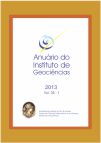Taphonomy of Spores of Pteridophyta Detected in Quaternary Peat Sediments in Rio de Janeiro, Brazil
DOI:
https://doi.org/10.11137/2013_1_55_63Abstract
Taphonomy is a tool used in palaeoenvironmental interpretations dating back to the process of palynomorphs deposition. The interpretation of taphonomic studies provides subsidies to the understanding of the environmental past conditions through the marks left on the preserved palynomorphs. The study area is located in the Praia Vermelha, Urca district, municipality of Rio de Janeiro, in the entrance of Guanabara Bay. The preservation of spores inside a columnar profile, constituted of peat and sandy mud sediments, was studied, comprising a time interval from about 4,520 to 4,270 years B.P. Eight levels were selected and sampled. The spores were classified according to the type of deterioration, by damages of corrosion and degradation and by mechanical damages. The percentage of each kind of deterioration was calculated in relation to the total number of counted spores and the concentration in relation to one cm³ of sediment. A large number of spores presenting corrosion and degradation damages was observed, being characteristic of air exposure, indicating occasions of lower water availability in this site. The predominance of undamaged spores in some levels suggests an underwater sedimentation, corroborated by sedimentary analyses.Downloads
Download data is not yet available.
Downloads
Published
2013-01-01
How to Cite
Bartholomeu, R. L., Barros, M. A. de and Barth, O. M. (2013) “Taphonomy of Spores of Pteridophyta Detected in Quaternary Peat Sediments in Rio de Janeiro, Brazil”, Anuário do Instituto de Geociências. Rio de Janeiro, BR, 36(1), pp. 55–63. doi: 10.11137/2013_1_55_63.
Issue
Section
não definida
License
This journal is licensed under a Creative Commons — Attribution 4.0 International — CC BY 4.0, which permits use, distribution and reproduction in any medium, provided the original work is properly cited.















